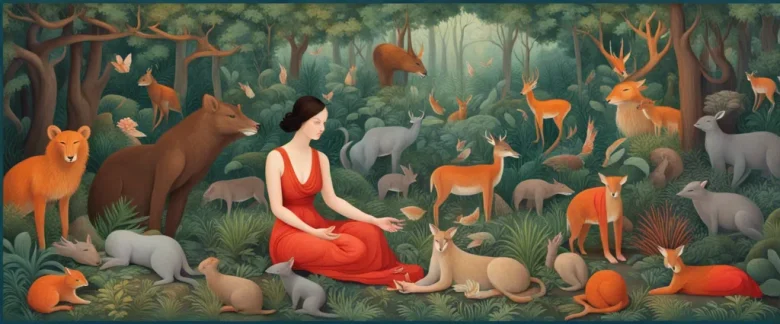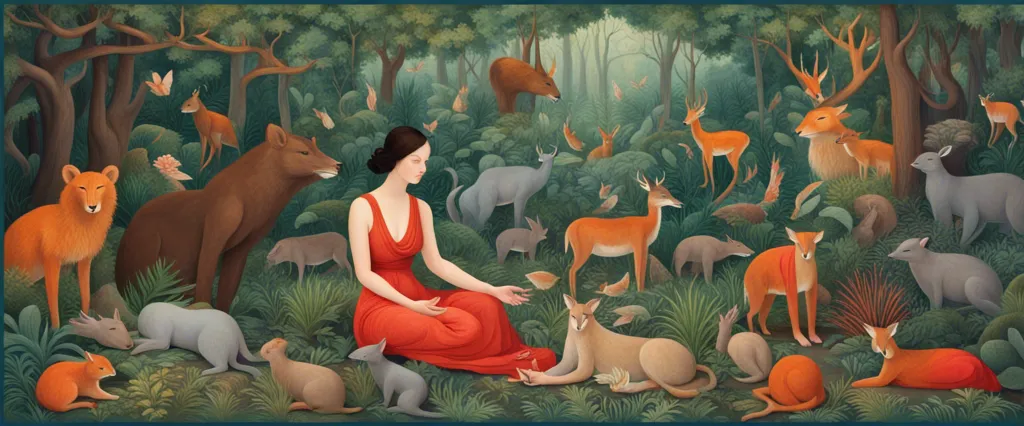In “Women Who Run With the Wolves,” renowned psychoanalyst and storyteller Clarissa Pinkola Estés presents a powerful and transformative exploration of the wild feminine nature. Drawing on myths, folktales, and her own clinical experience, Estés invites women to reconnect with their instinctual, intuitive selves, and reclaim their innate power and creativity. Through her captivating stories and insightful analysis, she delves into the archetypal figures of the wild woman and the wolf, guiding readers on a journey of self-discovery and healing. Offering ancient wisdom for the modern woman, Estés illuminates the path towards self-empowerment, liberation, and wild self-expression.
Chapter 1: The Return of the Wild
Chapter 1: The Return of the Wild of the book Women Who Run With the Wolves by Clarissa Pinkola Estés introduces the concept of the wild woman archetype and its importance in women’s lives. Estés shares myths, tales, and psychological analysis to explore the inherent wildness within women and how it has often been suppressed throughout history.
The chapter begins by exploring the story of “Bluebeard,” a French folktale in which a man with a blue beard marries multiple wives but brutally murders them when they disobey him. Estés interprets this tale as a metaphor for the way society has tried to suppress women’s wild instincts and how women have internalized this repression.
She emphasizes the essential nature of the wild woman archetype, which represents the instinctual, creative, and intuitive aspects of a woman’s psyche. Estés argues that accessing this wildness is vital for a woman’s spiritual and psychological well-being.
Furthermore, she explores the negative consequences of suppressing the wild nature of women. Estés describes how this suppression can lead to unhappiness, dissatisfaction, and a loss of connection with oneself and the natural world. The author encourages women to reconnect with their wildness through various practices, including storytelling, dream analysis, and embracing their instincts.
In this first chapter, Estés introduces the central themes of the book and sets the foundation for the exploration of the wild woman archetype. By recognizing and embracing their inner wildness, Estés suggests that women can tap into their inherent strength and unlock their true potential.
Chapter 2: The Primal Power of Women
Chapter 2: The Primal Power of Women of the book Women Who Run With the Wolves explores the concept of the Wild Woman archetype and the innate power that resides within women. Clarissa Pinkola Estés explains that the Wild Woman is an essential part of a woman’s psyche, representing her intuitive and instinctual nature.
Estés draws on various mythological and traditional stories, such as the tale of The Handless Maiden, to illustrate the importance of reconnecting with this wild aspect of oneself. She argues that society often suppresses the Wild Woman, urging women to conform to societal expectations and conformist behaviors.
The chapter digs into the stories of ancient goddesses, highlighting their fierce and untamed qualities, emphasizing the vitality and wisdom that lies within this primal power. Estés encourages women to embrace their wildness, to listen to their instincts, and to reclaim their inner power.
Furthermore, she explains how the suppression of the Wild Woman can lead to a sense of detachment and disconnection in women’s lives. Describing the symptoms as “starvation,” Estés highlights how women may feel unfulfilled and yearn for a deep sense of connection.
Finally, Estés provides guidance on how to restore the Wild Woman within. She emphasizes the importance of introspection, self-reflection, and reclaiming one’s creativity. By accessing this primal power, women can uncover their true potential and live authentically in all aspects of their lives.
In summary, Chapter 2 of Women Who Run with the Wolves delves into the concept of the Wild Woman archetype, emphasizing the innate power and wisdom that resides within women. Estés highlights the societal suppression of this primal power and provides guidance on reclaiming and nourishing it in order to live a more fulfilling and authentic life.
Chapter 3: Journeying into the Inner World
Chapter 3: Journeying into the Inner World of Women Who Run With the Wolves delves deeper into the exploration of the female psyche and the innate, wild nature of women. Clarissa Pinkola Estés artfully weaves together various myths and folktales to explain the importance of embracing one’s wild and instinctual self.
The chapter begins by describing the concept of the “psychic cave,” which represents the internal world of a woman’s psyche – a sanctuary where her instincts, intuitions, and authentic self reside. Estés emphasizes the necessity of exploring and understanding this inner world in order to live a fulfilling and empowered life.
Estés introduces the mythological figure of Bluebeard, a wealthy man who marries numerous women and then murders them. Bluebeard serves as a metaphor for the destructive force that arises when women neglect their inner instincts and become disconnected from their wild nature. The author emphasizes that women must learn to discern between their true instincts and the pressures of a patriarchal society that seeks to tame and control them.
The chapter also introduces the concept of soul loss, a phenomenon where a woman loses parts of herself due to social conditioning or traumatic experiences. Estés highlights the importance of reclaiming these lost parts through inner work and self-exploration. She encourages women to embark on a journey into the psychic cave, confronting their fears and facing the darkness within in order to unleash their true potential.
In summary, Chapter 3 explores the significance of delving into the inner world of a woman’s psyche, reclaiming her wild nature, and embracing her true instincts. Through engaging storytelling and mythological references, Clarissa Pinkola Estés inspires women to embark on a transformative journey of self-discovery, empowering them to live authentically and fully embrace their wild selves.
Chapter 4: Liberating the Imprisoned Self

Chapter 4: Liberating the Imprisoned Self of “Women Who Run With the Wolves” by Clarissa Pinkola Estés delves into the concept of the “imprisoned self” and explores ways to liberate it. Estés begins by describing the various ways in which women’s true selves are often suppressed or imprisoned due to societal expectations and conditioning.
According to Estés, the imprisoned self is a result of external influences that have forced women to conform to a narrow set of roles and behaviors. She emphasizes the importance of acknowledging and understanding these external forces in order to free oneself from their influence. Estés uses the metaphor of the Wild Woman, a primal, instinctual, and free-spirited archetype, to guide women towards liberation.
The chapter is divided into sections that discuss different aspects of the imprisoned self. Estés explores themes such as the loss of instinct, the impact of cultural messages, and the importance of reclaiming one’s unique creative gifts and passions. She encourages women to reconnect with nature, the subconscious, and their own intuition as pathways to self-discovery.
Throughout the chapter, Estés weaves in myths, fairy tales, and personal stories to illustrate her points and provide guidance. She emphasizes the importance of self-acceptance, self-love, and self-expression as tools for breaking free from societal constraints.
Overall, Chapter 4 offers a roadmap for women to reclaim their innate wildness, embrace their true selves, and break free from the pressures and limitations imposed upon them. It serves as an empowering call to action, urging women to live authentically and find liberation within themselves.
Chapter 5: The Wisdom and Intuition of the Wolf
Chapter 5: The Wisdom and Intuition of the Wolf explores the symbolic significance of the wolf as a powerful archetype and emphasizes the importance of trusting one’s instincts and embracing the wildness within.
Clarissa Pinkola Estés describes the wolf as a representation of instinctual knowledge, intuition, and the wild feminine. She asserts that women, like wolves, possess an innate understanding and connection to their primal instincts, which can guide them towards a more authentic and fulfilling life.
The author uses various mythologies, folktales, and personal experiences to illustrate the wisdom of the wolf. She highlights the story of “La Loba,” the Wolf Woman, who collects the bones of animals and humans scattered throughout the desert to reassemble them into complete beings. Estés interprets this as a metaphor for women reclaiming their lost or forgotten instincts and reconnecting with their wild nature.
The author also explores the concept of “the Wild Woman,” which she defines as an untamed and free-spirited aspect of femininity that has been suppressed by societal expectations and constraints. She encourages women to embrace their wildness, follow their own instincts, and reject the limitations imposed upon them.
Additionally, Estés discusses the power of intuition, which she describes as a vital tool for navigating life’s challenges. Using various wolf-related stories, she emphasizes the importance of listening to one’s intuition, as it can provide valuable guidance and protect against potential dangers.
In summary, Chapter 5 of Women Who Run With the Wolves delves into the symbolism of the wolf archetype, emphasizing the wisdom and intuition inherent within women. By embracing their wild nature, trusting their instincts, and tapping into their intuitive abilities, women can awaken their authentic selves and navigate life with a renewed sense of purpose.
Chapter 6: Reclaiming the Female Narrative
Chapter 6: Reclaiming the Female Narrative in Women Who Run With the Wolves by Clarissa Pinkola Estés explores the power of storytelling as a means to reclaim and understand the female experience. Estés emphasizes the importance of women attuning to their natural instincts, intuition, and wild nature.
The chapter presents the tale of Vasilisa the Wise, a Russian folktale that serves as a metaphor for women’s journey towards empowerment and self-discovery. Vasilisa, a young girl whose mother dies, is left in the care of her stepmother and stepsisters. While her stepsisters represent the suppressing forces women often face in society, Vasilisa is accompanied by a doll—an inner guide that symbolizes intuition, wisdom, and inner strength.
Estés encourages women to listen to their intuitive voices and reconnect with their inner selves by nurturing their creative spirit. She emphasizes the importance of reclaiming the stories of ancestors and embracing their wisdom to break free from societal constraints. By doing so, women can transcend the limitations imposed upon them and regain their power.
Through exploring various psychological concepts, Estés illustrates the significance of embracing one’s feminine nature. She encourages women to embrace their natural instincts, which have often been neglected or devalued in patriarchal societies. Estés explores the necessity of setting boundaries, knowing when to say no, and the importance of discernment.
Chapter 6 of Women Who Run With the Wolves is a call to reclaim the narrative of women, encouraging them to liberate themselves from societal expectations and reconnect with their innate wisdom. With storytelling as a guiding tool, women can transform their lives and overcome the forces that seek to hold them back.
Chapter 7: Self-Healing and Inner Strength
Chapter 7: Self-Healing and Inner Strength of Women Who Run With the Wolves by Clarissa Pinkola Estés explores the concept of personal healing and the development of inner strength in women. Estés begins by emphasizing the importance of self-care and self-preservation in order for women to fully thrive in their lives.
She discusses the transformative power of the instinctual self, which can guide women in their healing journeys. Estés compares the metaphorical healing process to that of bones mending and growing stronger after being broken. She encourages women to honor their wounds and see them as opportunities for growth and learning.
The chapter then explores the idea of the “wild woman” archetype, a part of a woman’s psyche that is instinctual, passionate, and intuitive. Estés stresses the importance of reconnecting with this wild, untamed part of ourselves in order to tap into our inner strength. She provides examples of traditional storytelling from various cultures that illustrate the wild woman’s ability to heal, transform, and rise above adversity.
Furthermore, Estés emphasizes the significance of ritual and ceremony in the healing process. She explains how engaging in rituals can help women reclaim their power, reconnect with their intuition, and restore balance in their lives. By participating in these rituals, women can access their innate wisdom and develop a deep sense of inner strength.
In summary, Chapter 7 delves into the importance of self-healing and the cultivation of inner strength in women. Estés encourages women to embrace their wounds, reconnect with their wild and instinctual nature, and engage in healing rituals to reclaim their power and thrive.

Chapter 8: Reconnecting with Nature and the Sacred
Chapter 8 of “Women Who Run With the Wolves” by Clarissa Pinkola Estés is titled “Reconnecting with Nature and the Sacred.” In this chapter, the author explores the importance of reconnecting with the natural world and our own inner sacredness.
Estés begins by discussing the profound impact that distancing ourselves from nature has had on our lives. She argues that, as human beings, we are inherently connected to the natural world and that our disconnection from it has led to feelings of emptiness and disorientation. She emphasizes the need to rekindle our relationship with nature and learn from its wisdom, as it holds answers to our most primal and essential questions.
The author also delves into the concept of the sacred and its connection to nature. She suggests that our modern society has forgotten the sacredness that exists within everything, reducing it to mere objects or commodities. Estés encourages readers to remember and honor the sacred in their daily lives, whether it be through rituals, prayers, or interactions with nature.
Throughout the chapter, Estés shares various myths and folktales that emphasize the importance of reconnecting with nature and our own sacredness. She encourages readers to listen to their intuition, to embrace their wild instincts, and to engage in activities that foster a deeper connection with the natural world. By doing so, Estés believes that individuals can rediscover their inherent wisdom and atavistic knowledge, allowing them to live authentic and fulfilling lives.
In summary, Chapter 8 of “Women Who Run With the Wolves” revolves around the necessity of reconnecting with nature and the sacred within ourselves. Estés advocates for an understanding and reverence for the natural world, suggesting that through this reconnection, one can tap into their true inner wisdom and live a more meaningful existence.
After Reading
In conclusion, “Women Who Run With the Wolves” by Clarissa Pinkola Estés is a powerful and transformative book that explores the essence of the wild woman archetype. Estés delves into the depths of women’s psyches, uncovering the ancient wisdom and resilience that lies within them. Through a collection of myths, fairy tales, and personal anecdotes, she guides women on a journey of self-discovery and healing. By embracing their instincts, intuition, and connection to nature, women can unleash their true potential and embody the wild, untamed spirit that resides within them. This book serves as a powerful reminder for women to reclaim their feminine power, awaken their creativity, and live authentically in a world that often seeks to suppress their wild nature.
1. “Untamed: Stop Pleasing, Start Living” by Glennon Doyle
This book explores themes of women reclaiming their power, embracing their wild nature, and breaking free from societal expectations. Like “Women Who Run With the Wolves,” it encourages women to reconnect with their intuition and inner strength.
2. “The Heroine’s Journey: Woman’s Quest for Wholeness” by Maureen Murdock
Drawing from myths, fairy tales, and Jungian psychology, this book examines the inner journey of women and offers guidance on finding personal empowerment, balance, and transformation. It shares similarities with the psychological explorations in “Women Who Run With the Wolves.”
3. “The Red Tent” by Anita Diamant
This novel takes a unique perspective on female archetypes and empowerment. Set in ancient times, it tells the story of biblical women and their experiences in a sacred space—the red tent. Like Estés’ book, it delves into the power of women supporting one another, rituals, and the connection to nature.
4. “The Dance of the Dissident Daughter: A Woman’s Journey from Christian Tradition to Feminine Spirituality” by Sue Monk Kidd
In this memoir, Sue Monk Kidd recounts her own spiritual journey, questioning traditional religious beliefs and searching for a deeper, authentic connection to the divine as a woman. This book echoes the themes of reclaiming feminine power and spirituality explored in “Women Who Run With the Wolves.”
5. “Wild Mercy: Living the Fierce and Tender Wisdom of the Women Mystics” by Mirabai Starr
In “Wild Mercy,” Mirabai Starr draws upon the writings of women mystics from various religious traditions to explore the divine feminine and ways to access our own sense of spiritual wisdom and connection. This book shares the focus on spirituality and embracing one’s inner wisdom found in Estés’ book.




